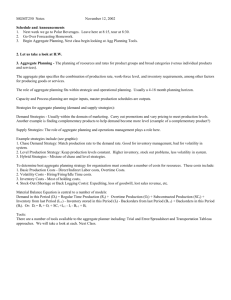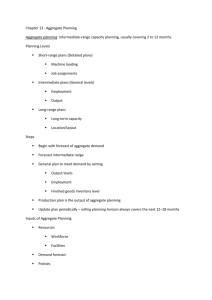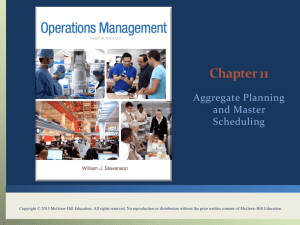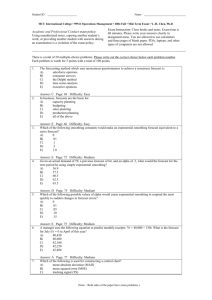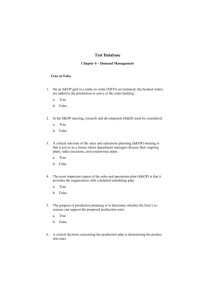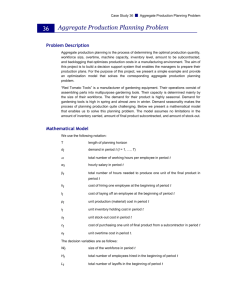Aggregate Planning Review Problems & Examples
advertisement
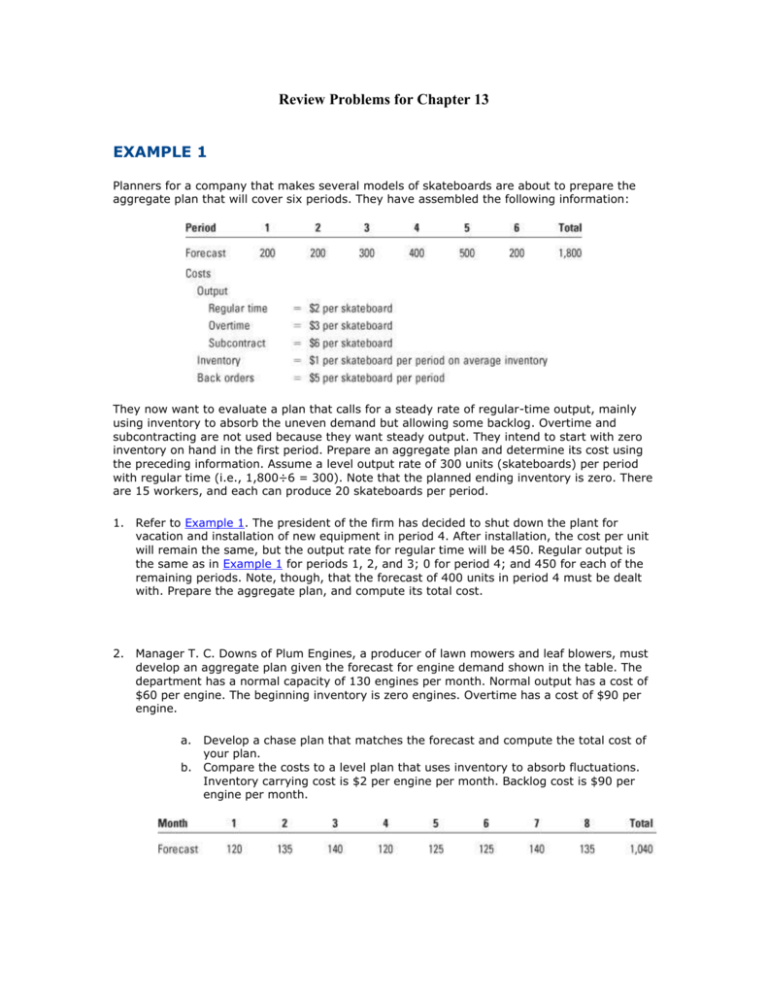
Review Problems for Chapter 13 EXAMPLE 1 Planners for a company that makes several models of skateboards are about to prepare the aggregate plan that will cover six periods. They have assembled the following information: They now want to evaluate a plan that calls for a steady rate of regular-time output, mainly using inventory to absorb the uneven demand but allowing some backlog. Overtime and subcontracting are not used because they want steady output. They intend to start with zero inventory on hand in the first period. Prepare an aggregate plan and determine its cost using the preceding information. Assume a level output rate of 300 units (skateboards) per period with regular time (i.e., 1,800÷6 = 300). Note that the planned ending inventory is zero. There are 15 workers, and each can produce 20 skateboards per period. 1. Refer to Example 1. The president of the firm has decided to shut down the plant for vacation and installation of new equipment in period 4. After installation, the cost per unit will remain the same, but the output rate for regular time will be 450. Regular output is the same as in Example 1 for periods 1, 2, and 3; 0 for period 4; and 450 for each of the remaining periods. Note, though, that the forecast of 400 units in period 4 must be dealt with. Prepare the aggregate plan, and compute its total cost. 2. Manager T. C. Downs of Plum Engines, a producer of lawn mowers and leaf blowers, must develop an aggregate plan given the forecast for engine demand shown in the table. The department has a normal capacity of 130 engines per month. Normal output has a cost of $60 per engine. The beginning inventory is zero engines. Overtime has a cost of $90 per engine. a. b. Develop a chase plan that matches the forecast and compute the total cost of your plan. Compare the costs to a level plan that uses inventory to absorb fluctuations. Inventory carrying cost is $2 per engine per month. Backlog cost is $90 per engine per month. 3. Nowjuice, Inc., produces bottled pickle juice. A planner has developed an aggregate forecast for demand (in cases) for the next six months. Use the following information to develop aggregate plans. Develop an aggregate plan using each of the following guidelines and compute the total cost for each plan. Which plan has the lowest total cost? 1. Use level production. Supplement using overtime as needed. 2. Use a combination of overtime (500 cases per period maximum), inventory, and subcontracting (500 cases per period maximum) to handle variations in demand. 3. Use overtime up to 750 cases per period and inventory to handle variations in demand. 4. Refer to Solved Problem 1. Prepare an aggregate plan that uses some combination of laying off ($100 per worker), subcontracting ($8 per unit, maximum of 20 units per period, must use for three consecutive periods), and overtime ($9 per unit, maximum of 25 per period, maximum of 60 for the planning horizon). Compute the total cost, and compare it with any of the other plans you have developed. Which plan has the lowest total cost? Assume you start with 21 workers. EXAMPLE 3 Given the following information set up the problem in a transportation table and solve for the minimum-cost plan: 5. Refer to Example 3. Suppose that an increase in warehousing costs and other costs brings inventory carrying costs to $2 per unit per month. All other costs and quantities remain the same. Determine a revised solution to this transportation problem. 6. Prepare a master schedule like that shown in the above Figure given this information: The forecast for each week of an eight-week schedule is 50 units. The MPS rule is to schedule production if the projected on-hand inventory would be negative without it. Customer orders (committed) are as follows: Use a production lot size of 75 units and no beginning inventory. 7. Determine the available-to-promise (ATP) quantities for each period for Problem 6.
